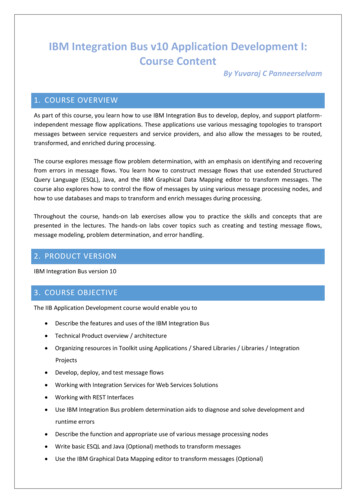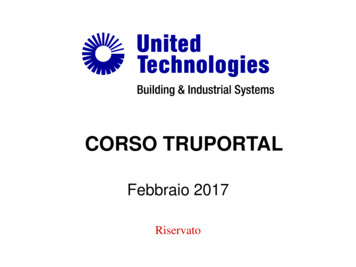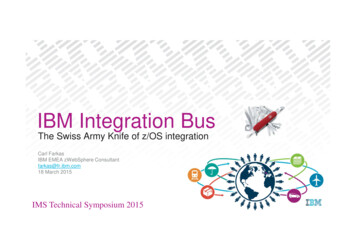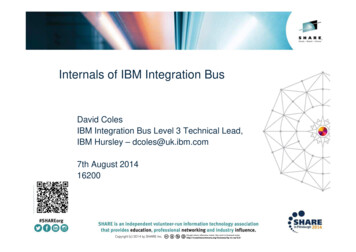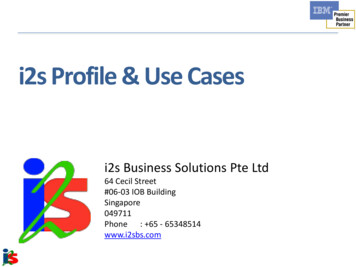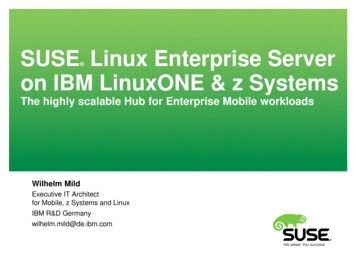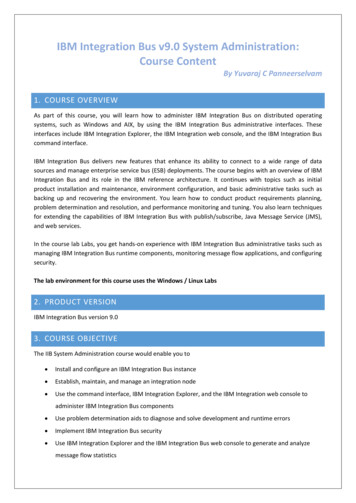
Transcription
IBM Integration Bus v9.0 System Administration:Course ContentBy Yuvaraj C Panneerselvam1. COURSE OVERVIEWAs part of this course, you will learn how to administer IBM Integration Bus on distributed operatingsystems, such as Windows and AIX, by using the IBM Integration Bus administrative interfaces. Theseinterfaces include IBM Integration Explorer, the IBM Integration web console, and the IBM Integration Buscommand interface.IBM Integration Bus delivers new features that enhance its ability to connect to a wide range of datasources and manage enterprise service bus (ESB) deployments. The course begins with an overview of IBMIntegration Bus and its role in the IBM reference architecture. It continues with topics such as initialproduct installation and maintenance, environment configuration, and basic administrative tasks such asbacking up and recovering the environment. You learn how to conduct product requirements planning,problem determination and resolution, and performance monitoring and tuning. You also learn techniquesfor extending the capabilities of IBM Integration Bus with publish/subscribe, Java Message Service (JMS),and web services.In the course lab Labs, you get hands-on experience with IBM Integration Bus administrative tasks such asmanaging IBM Integration Bus runtime components, monitoring message flow applications, and configuringsecurity.The lab environment for this course uses the Windows / Linux Labs2. PRODUCT VERSIONIBM Integration Bus version 9.03. COURSE OBJECTIVEThe IIB System Administration course would enable you to Install and configure an IBM Integration Bus instance Establish, maintain, and manage an integration node Use the command interface, IBM Integration Explorer, and the IBM Integration web console toadminister IBM Integration Bus components Use problem determination aids to diagnose and solve development and runtime errors Implement IBM Integration Bus security Use IBM Integration Explorer and the IBM Integration Bus web console to generate and analyzemessage flow statistics
Use the IBM Integration web console to record and reply messages Use workload management policies to adjust the processing speed of messages and control theactions that are taken on unresponsive flows and threads Subscribe to IBM Integration Bus topics Configure the integration node to support secure web services4. PRE-REQUISITES Should have working knowledge of IBM WebSphere MQ v7.5 System Administration Should have hands-on experience with Linux OS for linux labs5. REQUIRED SOFTWARESSoftwareWebSphere MQIBM Integration Bus PackageAny Databases*Version7.59For Virtualized EnvironmentSoftwareVM PlayerLinux OS – CentOS / OpenSUSE etcWebSphere MQ Runtime on LinuxWebSphere MQ Explorer on WindowsIBM Integration Bus Runtime on LinuxIBM Integration Toolkit & Explorer on WindowsAny Databases * (on Windows / Linux)Version6/77.57.599* - For performing labs pertaining to developing Database based solutions any database like Oracle, DB2, MySQLetc. is required. Lab instructions are provided for MySQL database.6. WHAT YOU GET?As part of the training, you would be receiving the following 15 hrs of Quality sessions (Theoretical Demo), Classroom / Online, suited or customized to yourrequirement at your comfortable pace All / Most of the sessions are accompanied with appropriate demo / hands-on to the extentpossible Session Presentation deck (PDF Format) Session Recordings (only for Candidates opting Online Training) Labs for most of the sessions (PDF Format), shared with Candidate to practice of their owno Lab document providing step-by-step instructions for performing various administrativetaskso Artifacts required for implementing the solutions
And finally our Support to your queries not only during the duration of the training, but alsobeyond the sessions (even after completion of the trainings)7. COURSE DETAILSUnit 1. IBM Integration Bus overviewDuration: 1 hourOverviewThis unit introduces the IBM reference architecture. You learn about the role of IBMIntegration Bus in a service-oriented architecture (SOA) as an enterprise service bus.You also learn about IBM Integration Bus application connectivity, and are introducedto the product components.LearningobjectivesAfter completing this unit, you should be able to: Position IBM Integration Bus within the IBM reference architecture Describe IBM Integration Bus connectivity options, including SCA Describe the main components of IBM Integration BusUnit 2. Product installation, configurationDuration: 1 hour and 30 minutesOverviewThis unit describes the installation preparation and procedures for IBM IntegrationBus. You learn how to configure the WebSphere MQ environment as a prerequisitestep for installing IBM Integration Bus.LearningobjectivesAfter completing this unit, you should be able to: List the prerequisite hardware and software for IBM Integration Bus Explain how to install IBM Integration Bus Create queue managers, integration nodes, and integration serversLab 1. Integration node setup and customizationDuration: 1 hourOverviewIn this Lab, you complete the configuration tasks that prepare the IBM Integration Busenvironment for use.LearningobjectivesAfter completing this Lab, you should be able to: Configure a Windows system for use with IBM Integration Bus Get build and version information for IBM Integration Bus components Create an integration node and integration server Find information in the help and IBM Integration Bus Information Center
Unit 3. Administration in the IBM Integration ToolkitDuration: 1 hourOverviewThis unit provides an overview of the administrative tasks that are available toapplication developers in the IBM Integration Toolkit.LearningobjectivesAfter completing this unit, you should be able to: Explain the function of the IBM Integration Toolkit Use the IBM Integration Toolkit to configure the IBM Integration Bus developmentenvironment Import a simple message flow Deploy a BAR file that contains a message flow to an integration server Test a deployed message flowLab 2. Using the IBM Integration ToolkitDuration: 1 hourOverviewIn this Lab, you use the IBM Integration Toolkit to complete basic post-installationconfiguration tasks. You also import, deploy, and test a message flow to learn theadministrative tasks that are available in the development environment.LearningobjectivesAfter completing this Lab, you should be able to: Import, deploy, and test a message flow Use the BAR file editor to examine the BAR file contentsUnit 4. Administration basicsDuration: 2 hoursOverviewIn this unit, you learn how to use commands, IBM Integration Explorer, the IBMIntegration web console, and the IBM Integration API Exerciser to configure andadminister the integration node and integration node components. The unit alsodescribes how to back up and restore critical resources.LearningobjectivesAfter completing this unit, you should be able to: Use IBM Integration Bus commands, IBM Integration Explorer, the IBMIntegration web console, and the IBM Integration API Exerciser to administer theintegration node Backup and restore critical resourcesLab 3. Administering the runtime componentsDuration: 1 hour and 30 minutesOverviewIn this Lab, you use IBM Integration Bus commands, IBM Integration Explorer, and theIBM Integration web console to manage IBM Integration Bus runtime components. Youalso backup and restore the integration node configuration data.LearningobjectivesAfter completing this Lab, you should be able to: Administer IBM Integration Bus components by using IBM Integration Buscommands, IBM Integration Explorer, and the IBM Integration web console Create an integration set in IBM Integration Explorer Backup and restore the integration node and its configuration data
Unit 5. Implementing IBM Integration Bus securityDuration: 1 hour and 30 minutesOverviewThis unit describes how to implement integration node component security, messageflow security, and integration node administration security. It also describes how toconfigure access authority for the IBM Integration web console.LearningobjectivesAfter completing this unit, you should be able to: Configure integration node administration security to control the authorities thatdevelopers and administrators use to complete their specific tasks Use security profiles to implement message flow security Implement security for the IBM Integration web consoleLab 4. Administering IBM Integration Bus securityDuration: 1 hourOverviewIn this Lab, you set and test IBM Integration Bus access control for the integrationnodes, integration servers, and message flows.LearningobjectivesAfter completing this Lab, you should be able to: Activate administration authority Assign security permissions for integration nodes, integration servers, andmessage flows with IBM Integration Explorer and IBM Integration Bus commands Use the IBM Integration API Exerciser to test the secured environmentUnit 6. Diagnosing problemsDuration: 1 hour and 30 minutesOverviewThis unit introduces you to the tools and approaches to use for detecting andcorrecting problems with IBM Integration Bus components and applications at runtime.LearningobjectivesAfter completing this unit, you should be able to: Describe the default message flow behavior when an error occurs Configure message flows for transactional behavior Diagnose common problems in the IBM Integration Bus environmentLab 5. Using trace facilitiesDuration: 45 minutesOverviewIn this Lab, you use the IBM Integration Bus problem diagnosis tools to identifyproblems in message flow applications. You enable and disable trace nodes, usertraces, and service traces to capture runtime information.LearningobjectivesAfter completing this Lab, you should be able to: Enable and disable a trace node within a message flow Activate a user trace and service trace to capture information Administer trace nodes and the message flow debugger
Lab 6. Identifying runtime problemsDuration: 1 hourOverviewThis Lab contains two parts. In the first part, you analyze a series of message flowsthat produce runtime errors, and determine where the incoming messages are foundafter the errors occur. In the second part of the Lab, you analyze and correct errorsituations that involve the IBM Integration Bus and the WebSphere MQ queuemanager.LearningobjectivesAfter completing this Lab, you should be able to: Describe the symptoms of runtime and environmental problems Isolate a problem to a particular component Determine the cause of a problem and correct itUnit 7. Monitoring integration node and message flow performanceDuration: 2 hoursOverviewIn this unit, you learn how to collect performance statistics and monitor data forintegration node components and message flows. The unit also provides details onmessage flow event monitoring and how to create monitoring profiles that you can useto set runtime monitoring options. For audit or problem determination purposes, youlearn how to record data to a database, and then view and replay it. You also learn theprinciples of tuning the integration node environment for optimal performance.LearningobjectivesAfter completing this unit, you should be able to: Explain IBM Integration Bus runtime measurement capabilities Describe the IBM Integration Bus tools for formatting gathered information,including text output and XML output View runtime statistics in IBM Integration Explorer and the IBM Integration webconsole Create an event monitoring profile Enable an integration node for recording and replaying messages Identify opportunities for improving performanceLab 7. Recording and replaying message flow dataDuration: 1 hourOverviewIn this Lab, you enable monitoring events and then record and replay messages. Youalso capture and report failed events.LearningobjectivesAfter completing this Lab, you should be able to: Activate message flow monitoring View event messages in the IBM Integration web console Replay messages Capture and report failed events
Unit 8. Publish/subscribe implementation overviewDuration: 45 minutesOverviewIn this unit, you learn how WebSphere MQ and IBM Integration Bus implementpublish/subscribe messaging.LearningobjectivesAfter completing this unit, you should be able to: Manage WebSphere MQ and IBM Integration Bus publish/subscribe integrationLab 8. Viewing runtime statisticsDuration: 1 hourOverviewIn this Lab, you enable integration node statistics collection and view the collectedstatistics with IBM Integration Explorer and the IBM Integration web console. You alsocreate a subscription for the integration node statistics and write them to a queue.LearningobjectivesAfter completing this Lab, you should be able to: Enable integration node resource and message flow statistics View integration node statistics in IBM Integration Explorer and the IBM Integrationweb console (Web-based Visualization and Performance Analysis) Set up a subscription for integration node statisticsUnit 9. Configuring IBM Integration Bus for high availabilityDuration: 1 hour and 45 minutesOverviewIn this unit, you learn the basic configurations that take advantage of high availabilityprocessing in the IBM Integration Bus environment. You also learn how to useworkload management policies to specify goals for the processing rate of a messageflow.LearningobjectivesAfter completing this unit, you should be able to: Explain the goals and challenges of developing highly available systems Describe how WebSphere MQ and IBM Integration Bus can implement highavailability processing Use the IBM Integration Bus global cache to store data that you want to reuseand share between integration nodes Use workload management policies to adjust the rate at which messages areprocessed and control the actions that are taken on unresponsive flows andthreadsLab 9. Managing unresponsive message flowsDuration: 1 hourOverviewIn this Lab, you learn how to set Workload Management properties in an IBMIntegration Bus BAR file to automatically force an unresponsive message flow to stop.LearningobjectivesAfter completing this Lab, you should be able to: Manually force an unresponsive message flow to stop Policy-based Workload Management and Flow Management - Specify themaximum amount of time that any message flow is allowed to process a message Specify an action to take if the message flow exceeds the maximum processingtime
Unit 10. Administering web servicesDuration: 1 hourOverviewIn this unit, you learn how to administer message flows that use HTTP and HTTPS toprovide web services. The unit also describes how to implement security for SOAPnodes by using policy sets and policy set bindings.LearningobjectivesAfter completing this unit, you should be able to: Describe the implementation of the HTTP and HTTPS nodes in an IBMIntegration node Implement Secure Sockets Layer (SSL) in support of HTTP nodes Create a policy setLab 10. Implementing web services and web services securityDuration: 1 hour and 30 minutesOverviewIn this Lab, you configure the integration node runtime environment to support webservices. You also use the supplied tools to set up a web service that can acceptinformation from or deliver it to a transport with secure HTTP (HTTPS).LearningobjectivesAfter completing this Lab, you should be able to: Implement message flows that provide and use a web service Configure web service support Implement a web service message flow that uses HTTPS for secure transport
Unit 1. IBM Integration Bus overview Duration: 1 hour Overview This unit introduces the IBM reference architecture. You learn about the role of IBM Integration Bus in a service-oriented architecture (SOA) as an enterprise service bus. You also learn about IBM Integration Bus application connectivity, and are introduced to the product components.
